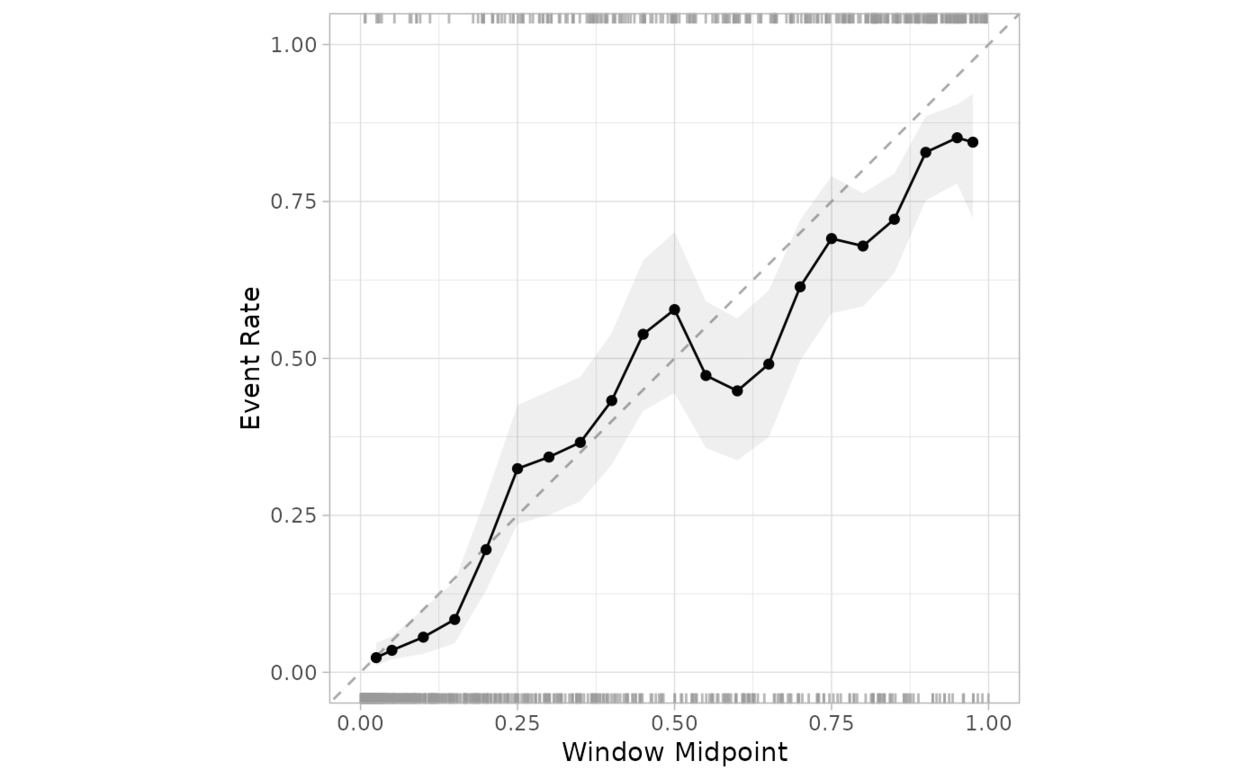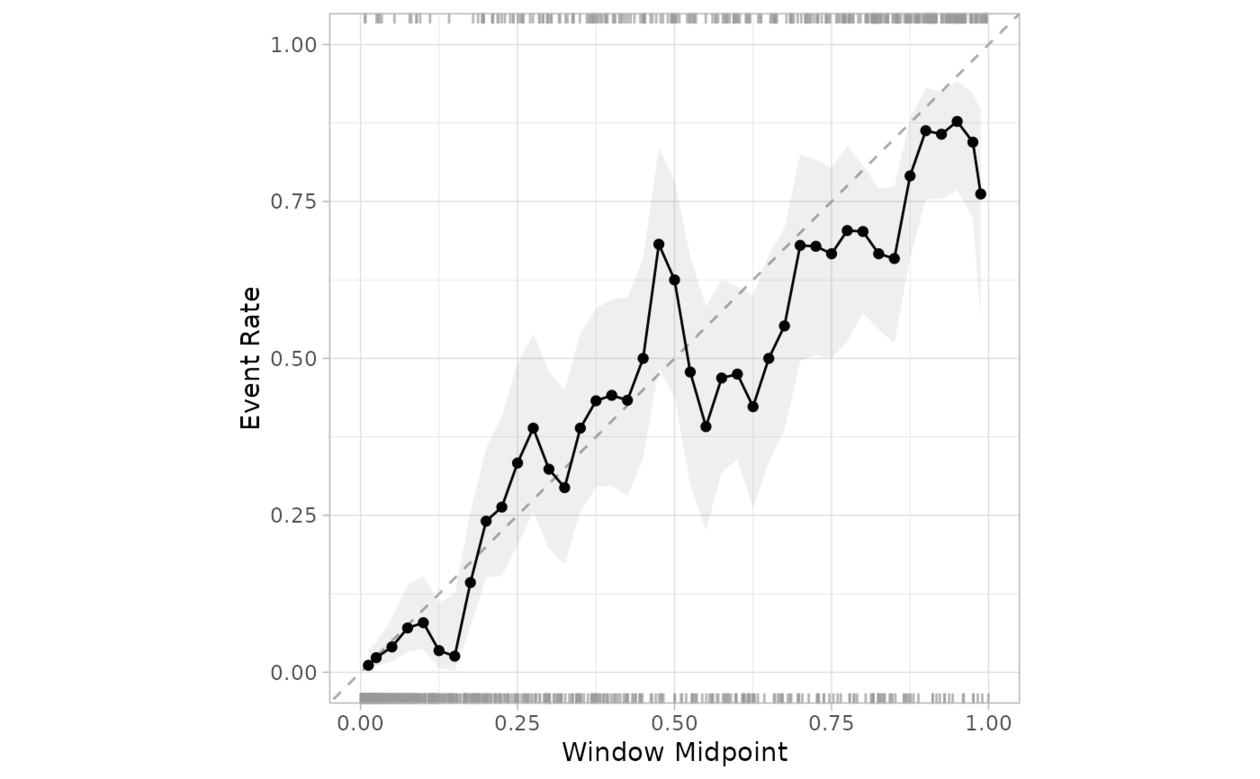创建一个图来评估观察到的事件发生率是否与样本有关,作为某个模型的事件预测概率。这与 cal_plot_breaks() 类似,只是 bin 重叠。
从 0 到 1 创建一系列 bin。对于每个箱,预测概率落在箱范围内的数据用于计算观察到的事件率(以及事件率的置信区间)。
如果预测经过良好校准,拟合曲线应与对角线对齐。
用法
cal_plot_windowed(
.data,
truth = NULL,
estimate = dplyr::starts_with(".pred"),
window_size = 0.1,
step_size = window_size/2,
conf_level = 0.9,
include_ribbon = TRUE,
include_rug = TRUE,
include_points = TRUE,
event_level = c("auto", "first", "second"),
...
)
# S3 method for data.frame
cal_plot_windowed(
.data,
truth = NULL,
estimate = dplyr::starts_with(".pred"),
window_size = 0.1,
step_size = window_size/2,
conf_level = 0.9,
include_ribbon = TRUE,
include_rug = TRUE,
include_points = TRUE,
event_level = c("auto", "first", "second"),
...,
.by = NULL
)
# S3 method for tune_results
cal_plot_windowed(
.data,
truth = NULL,
estimate = dplyr::starts_with(".pred"),
window_size = 0.1,
step_size = window_size/2,
conf_level = 0.9,
include_ribbon = TRUE,
include_rug = TRUE,
include_points = TRUE,
event_level = c("auto", "first", "second"),
...
)
# S3 method for grouped_df
cal_plot_windowed(
.data,
truth = NULL,
estimate = NULL,
window_size = 0.1,
step_size = window_size/2,
conf_level = 0.9,
include_ribbon = TRUE,
include_rug = TRUE,
include_points = TRUE,
event_level = c("auto", "first", "second"),
...
)参数
- .data
-
包含预测和概率列的未分组 DataFrame 对象。
- truth
-
真实类别结果的列标识符(即一个因子)。这应该是一个不带引号的列名。
- estimate
-
列标识符向量,或
dplyr选择器函数之一,用于选择哪些变量包含类概率。它默认为 tidymodels 使用的前缀 (.pred_)。标识符的顺序将被视为与truth变量的级别顺序相同。 - window_size
-
段的大小。用于加窗概率计算。默认为段的 10%。
- step_size
-
段之间的间隙。用于加窗概率计算。默认为
window_size大小的一半 - conf_level
-
可视化中使用的置信度。默认为 0.9。
- include_ribbon
-
指示是否要包含函数区层的标志。默认为
TRUE。 - include_rug
-
指示是否要包括地毯层的标志。默认为
TRUE。在图中,顶部显示事件发生的频率,底部显示事件未发生的频率。 - include_points
-
指示是否要包含点图层的标志。
- event_level
-
单字符串。 "first" 或 "second" 指定将哪个真实级别视为 "event"。默认为"auto",它允许函数根据模型类型(二元、多类或线性)决定使用哪一个
- ...
-
传递给
tune_results对象的其他参数。 - .by
-
分组变量的列标识符。这应该是一个不带引号的列名称,用于选择用于分组的定性变量。默认为
NULL。当.by = NULL时,不会进行分组。
相关用法
- R probably cal_plot_logistic 通过逻辑回归绘制概率校准图
- R probably cal_plot_breaks 通过分箱绘制概率校准图
- R probably cal_plot_regression 回归校准图
- R probably cal_estimate_multinomial 使用多项校准模型来计算新的概率
- R probably cal_validate_logistic 使用和不使用逻辑校准来测量性能
- R probably cal_validate_isotonic_boot 使用和不使用袋装等渗回归校准来测量性能
- R probably cal_estimate_beta 使用 Beta 校准模型来计算新概率
- R probably cal_estimate_isotonic 使用等渗回归模型来校准模型预测。
- R probably cal_estimate_logistic 使用逻辑回归模型来校准概率
- R probably cal_validate_multinomial 使用和不使用多项式校准来测量性能
- R probably cal_apply 对一组现有预测应用校准
- R probably cal_validate_linear 使用和不使用线性回归校准来测量性能
- R probably cal_estimate_isotonic_boot 使用引导等渗回归模型来校准概率
- R probably cal_validate_isotonic 使用和不使用等渗回归校准来测量性能
- R probably cal_estimate_linear 使用线性回归模型来校准数值预测
- R probably cal_validate_beta 使用和不使用 Beta 校准来测量性能
- R probably class_pred 创建类别预测对象
- R probably append_class_pred 添加 class_pred 列
- R probably threshold_perf 生成跨概率阈值的性能指标
- R probably as_class_pred 强制转换为 class_pred 对象
- R probably levels.class_pred 提取class_pred级别
- R probably locate-equivocal 找到模棱两可的值
- R probably int_conformal_quantile 通过保形推理和分位数回归预测区间
- R probably make_class_pred 根据类概率创建 class_pred 向量
- R probably reportable_rate 计算报告率
注:本文由纯净天空筛选整理自Max Kuhn等大神的英文原创作品 Probability calibration plots via moving windows。非经特殊声明,原始代码版权归原作者所有,本译文未经允许或授权,请勿转载或复制。


